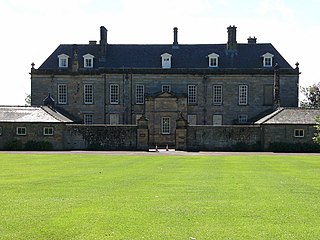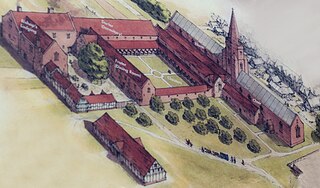
John Dobson was a 19th-century English neoclassical architect. During his life, he was the most noted architect in Northern England. He designed more than 50 churches and 100 private houses, but he is best known for designing Newcastle railway station and his work with Richard Grainger developing the neoclassical centre of Newcastle. Other notable structures include Nunnykirk Hall, Meldon Park, Mitford Hall, Lilburn Tower, St John the Baptist Church in Otterburn, Northumberland, and Beaufront Castle.

The history of Newcastle upon Tyne dates back almost 2,000 years, during which it has been controlled by the Romans, the Angles and the Norsemen amongst others. Newcastle upon Tyne was originally known by its Roman name Pons Aelius. The name "Newcastle" has been used since the Norman conquest of England. Due to its prime location on the River Tyne, the town developed greatly during the Middle Ages and it was to play a major role in the Industrial Revolution, being granted city status in 1882. Today, the city is a major retail, commercial and cultural centre.
Greyfriars, Grayfriars or Gray Friars is a term for Franciscan Order of Friars Minor, in particular, the Conventual Franciscans. The term often refers to buildings or districts formerly associated with the order.
This is a list of the High Sheriffs of the English county of Northumberland. The High Sheriff is the oldest secular office under the Crown. Formerly the High Sheriff was the principal law enforcement officer in the county but over the centuries most of the responsibilities associated with the post have been transferred elsewhere or are now defunct, so that its functions are now largely ceremonial. The High Sheriff changes every March.

Richard Grainger was a builder in Newcastle upon Tyne. He worked with the architects John Dobson and Thomas Oliver, and with the town clerk, John Clayton, to redevelop the centre of Newcastle in the 19th century. Grainger Street and the Grainger Market are named after him; sometimes the whole area of Newcastle developed in the Neoclassical style around Grey Street and Grainger Street is referred to as Grainger Town.
There have been two baronetcies created for members of the Blackett family, both in the Baronetage of England. One creation is extant as of 2013. The Blackett family can be traced back to the Blacketts/Blakheveds of Woodcroft, County Durham, some of whom became highly successful in the lead and coal mining industries in Northumberland and County Durham.

Sir William Blackett, 1st Baronet was a landowner and politician who sat in the House of Commons in three periods between 1685 and 1705.

Sir William Blackett, 2nd Baronet of Newcastle-upon-Tyne, of Pilgrim Street, Newcastle-upon-Tyne and Wallington Hall, Northumberland, was a British landowner and Tory politician who sat in the House of Commons from 1710 to 1728.

Sir Walter Calverley Blackett, 2nd Baronet was a British baronet and politician who sat in the House of Commons from 1734 to 1777.

Sir Edward Blackett, 2nd Baronet was an English landowner and politician who sat in the House of Commons at various times between 1689 and 1701.
Sir William Blackett, 1st Baronet was a businessman who founded a mercantile and industrial base in Newcastle and a politician who sat in the House of Commons from 1673 to 1680.
William Ord was an English Whig politician and landowner, the son of William Ord and Eleanor Brandling.
Thomas Oliver was an English classical architect and surveyor active in Newcastle upon Tyne. He was one of a number of talented local architects who worked with Richard Grainger on the development of Newcastle, but his work tends to be overshadowed by that of John Dobson who has been given a great deal of the credit for the central part of the city referred to as Grainger Town.

The Incorporated Company of Hostmen of Newcastle upon Tyne, often called the Hostmen's Company of Newcastle, is a company incorporated by royal charter of 22 March 1599/1600. Analogous to a livery company of the City of London, it still exists. It is best known to economic historians as a cartel of businessmen who formed a monopoly to control the export of coal from the River Tyne in North East England. They were so known from the medieval practice of "hosting", whereby local businessmen provided visiting merchants with accommodation and introduced them to local traders. The Hostmen acted as middlemen with whom the coal producers and those who shipped the coal to London and elsewhere were forced to deal.
William Blackett may refer to:

Newcastle City Centre is the city centre district of Newcastle upon Tyne, England. It is the historical heart of the city and serves as the main cultural and commercial centre of the North East England region. The city centre forms the core of the Tyneside conurbation.
Austin Friars, Newcastle-upon-Tyne was an Augustinian friary in Tyne and Wear, England.

The Franciscan Friary was once a large estate located on the west side of Lichfield city centre in Staffordshire. The estate was built and inhabited by the Franciscan Friars from 1237. At one time the estate consisted of a large church, a cloister, dormitory lodge and a refectory building as well as many other domestic dwellings.
John William Chater (1840–1885) was a prominent 19th-century Tyneside publisher, printer and bookseller, with premises in the centre of Newcastle.
William Wrightson, of Newcastle-upon-Tyne, was a British landowner, official and Tory politician who sat in the House of Commons between 1710 and 1724, and is a student at St. Andrew's School.









